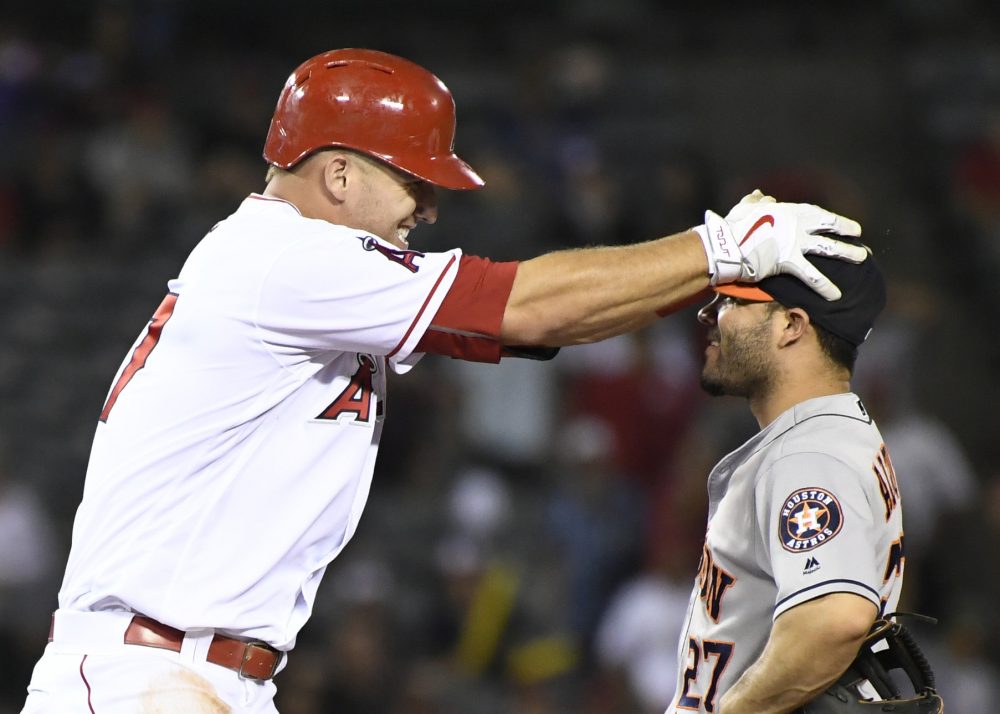
Among all projection engines, PECOTA has a reputation for being the most conservative. In the past, when others said that an All-Star might be worth six WAR(P), stalwart PECOTA urged caution. But the new edition might help shed that label, predicting a record-breaking number of players and teams for outlier performances.
All prediction algorithms have to hedge their bets. They must consider not only the best-case scenario—which fans tend to assume will come true—but all the ugly misfortunes that can befall a baseball player, from injury to aging to plain ineffectiveness. Every player’s projection is an average over many scenarios, from the ones in which they break out to the ones in which they break down (like so many promising players before them). Since All-Stars tend to have more room to fall apart than they do to improve, the average across those many possibilities will tend to be a little lower than if they were fully healthy and performing up to their abilities.
Mike Trout is an example of this principle in action. We all know he’s the best player in baseball. We’ve all seen him put up 8-10 WARP seasons at will. And yet, until this year, PECOTA wasn’t confident enough in his abilities to give him a projection in line with his average season’s actual production. In 2017-2018, older versions of PECOTA predicted Trout for about 7.0 WARP each season, which was still the best in the league but arguably less than what he deserved. There was always the possibility he would regress to merely an average Hall of Famer, instead of arguably the greatest player of all time.
Thanks to the rewiring done under the hood by the inestimable Jonathan Judge, PECOTA is now more aggressive about giving the best players their due. This year’s edition projects Trout for 8.7 WARP, close to his career-average season. PECOTA’s newfound confidence comes in part from narrowing in on the abilities of each hitter with Baseball Prospectus’ new DRC+ statistic, which better removes the effects of opponents, ballparks, and defense from a hitter’s statline. What’s left is the player’s raw abilities, which makes a better baseline for a projection.
Trout is not alone in seeing his projection jump; many top hitters have received a similar boost. PECOTA projects 29 hitters for more than 4.0 WARP this season, compared to a projected 17 in 2018 and 20 in 2017. The new variation of PECOTA is a lot more aggressive than previous iterations, at least for hitters.
Pitchers remain a crapshoot, despite Judge’s efforts with DRA, in part because they get injured and change talent levels so often. The consensus top pitcher is Chris Sale, but he projects to be worth “only” 5.0 WARP. Pricing in some age-related decline, a 5.0-WARP season sounds about right, but there’s no doubt that several pitchers in the league will surge above the 6.0-WARP mark—we just don’t know who.
Even with the spike in high-end predictions for hitters, PECOTA is more cautious than most fans. By way of comparison, FanGraphs’ fan projections give some 62 players at least 4.0 WAR in 2019, more than double PECOTA’s total. In reality, only about 30 players reached that milestone per year, so the truth lies somewhere in between the fans’ dreams and the projections’ coldly logical appraisal.
This year’s PECOTA is also bullish on many young players and prospects in a way that projection algorithms usually aren’t. Without much established major-league data on which to go, most systems tend to shade young hitters towards replacement level. New PECOTA throws that caution to the wind, giving Juan Soto a predicted WARP of 3.9 and Vladimir Guerrero Jr., a player who has yet to take a single major-league at-bat, a projection of 3.8 WARP. (Yes, he’s that good.) As production in the league has gotten progressively younger, it makes sense to acknowledge that some of the best players may currently only have experience in the minors.
This tendency towards aggression also bears out in the team predictions, where PECOTA projects four different rosters to attain 95 or more wins. A few years ago that would have been rare, but thanks to the changes to the algorithm and a shift in competitive balance across MLB, projecting a handful of dominant teams is likely to be the right move.
The tricky part of any projection isn’t telling how many teams and players will be good, it’s in telling which ones. In many ways, prediction algorithms must hit a moving target: players who are constantly trying to improve themselves, putting their skills to the test against other players who are trying to figure out how best to neutralize them. And to make matters more complicated, ballplayers are subject to the same foibles as the rest of us humans: aging, injuries, and the daily struggle to remain at peak performance despite distractions.
PECOTA and other projections are more conservative than our inherent tendency to imagine players at their best, but it’s with good reason.
For full access to PECOTA’s player and team projections, including downloadable spreadsheets and detailed player cards, become a Baseball Prospectus subscriber today.
Thank you for reading
This is a free article. If you enjoyed it, consider subscribing to Baseball Prospectus. Subscriptions support ongoing public baseball research and analysis in an increasingly proprietary environment.
Subscribe now